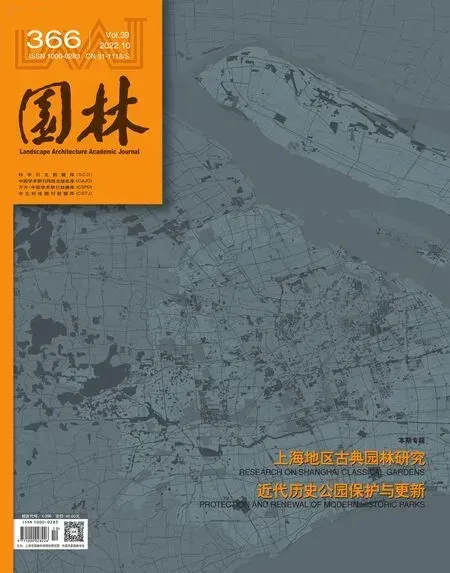上海历史园林的保护与可持续利用
历史园林(historic gardens)的概念由国际古迹遗址理事会(ICOMOS)与国际历史园林委员会于1982年颁布的《佛罗伦萨宪章》中确定,并表述其为:是一种文化、一种风格、一个时代的见证。历史园林的类型涵盖小型花园(small gardens)和大型公园(large parks),分为古代历史园林和近现代历史园林。《中华人民共和国文物保护法》(2002年)将历史园林归类为“物质类”,其中历史园林仅包括古典园林。自20世纪90年代以来,中国大规模的城市更新给历史园林的保护及再生带来了机遇与挑战,历史园林作为特定的遗产类型,是典型的物质文化遗产,其保护与可持续利用是地域性园林传承和融合的重要基础。
古典园林的兴衰是一个城市经济、社会、文化发展的直接标志。上海古典园林于南北朝开始逐步发展,明嘉靖十五年(1536年)后进入修建高潮期,在理论和实践中仍保持创新,形成了开放又自成一体的独特风格,这种具有创新意识地善于用“在地自然资源”,正是其兼容并蓄的优秀品格。本期专题1聚焦“上海地区古典园林研究”,江滩水远是一种更为悠远的、植根于上海这片土地的情结,通过地域风貌对人及物的深度浸润,成为造园者一种内化自觉的审美意识与营园偏好,继而成为了“西风东渐下”驱动近代上海私园变迁的内在动力;伴随近年来计算机技术、遥感技术的进步,文化遗产研究和保护进入了数字化阶段,为解决遗产保护中的特征评价这一关键问题寻找到了技术途径,尤其是在传统假山营造智慧的传承和推广应用方面;古园的变迁史研究以及重修则不仅是对传统文人造园理论的实践印证,更饱含传统文人借园林笔墨,吐情怀志趣之深意,宣誓了造园工作者的时代意识,承寄了传统园林艺术上征而向荣的殷殷理想。
近代公园(又称近代历史公园,modern historic parks)指建于中国近代(1840-1949年)作为城市公共空间对公众开放的园林。其具有区别于古典园林的特殊文化遗产价值,见证了城市特定时期的发展历程。上海是中国近代公园的发源地,其近代公园更新改造需求尤为迫切。如何保护近代公园的特殊历史价值不在更新中被磨灭,又如何更新才能在保护历史的同时获得持续的发展和活力?本期专题2聚焦“近代历史公园保护与更新”,拓展了“纪念”在历史公园保护和更新中的作用,强调了保存物质本体作为历史延续的稳定基础,同时应积极挖掘本体潜存的符号纪念意义,激发公园活力和新纪念空间的诞生;归纳了近代城市公园游憩功能的形成发展,提出近代公园的有机更新与保护途径需坚持与城俱进,并突出以人的休闲游憩需求与体验为基本目的;提出近代公园附属设施配置应当根据人群多元需求将“品质提升”具体化为设施类型、功能、服务的提升,并构建了针对近代公园的附属设施配置标准。
历史园林记录和承载了城市历史过程的演变,表现为系统发掘或遗产秩序,融入了现代社会日常生活,外化为城市游憩活动的新引擎,与城融合、与城俱进,才能不断焕发新的生命力与活力,兼具发展的持久力。本期对上海古典园林以及近代历史公园的研讨,为历史园林领域理论体系的完善,保护、修复及特征评价技术方法的更新作了梳理。相信风景园林领域的学者们还将会继续深耕,以推进中国地域性历史园林保护利用研究和制度体系建设的不断完善。
主编
2022年9月2日
Protection and Sustainable Utilization of Historical Gardens in Shanghai
The concept of “historical gardens” was defined inThe Florence Charterissued by ICOMOS and the International Commission on Historic Gardens in 1982, and expressed as: a culture, a style and a witness of an era.The types of historic gardens include small gardens and large parks, which are divided into ancient historical gardens and modern historical gardens.The Law of the People’s Republic of China on the Protection of Cultural Relics(2002) class ifi es historic gardens as “material”,in which historic gardens only include classical gardens.Since the 1990s, China’s large-scale urban renewal has brought opportunities and challenges to the protection and regeneration of historic gardens.As a spec ifi c type of heritage, historic gardens are typical material cultural heritage, and their protection and sustainable utilization are important foundations for the inheritance and integration of regional gardens.
The rise and fall of classical gardens is a direct sign of the economic, social and cultural development of a city.Shanghai classical gardens began to develop gradually in the Southern and Northern Dynasties.After the 15th year of Jiajing in Ming Dynasty (1536), it entered a period of construction climax.Shanghai classical gardens remained innovative in theory and practice, and formed a unique style of openness and integration.This kind of innovative awareness of being good at using“local natural resources” is its excellent character of inclusiveness.Topic 1 of this issue focuses on “Research on Shanghai Classical Gardens”.Jiangtan Shuiyuan is a more distant complex rooted in the land of Shanghai.Through the deep infiltration of the regional landscape, it has become an internalized conscious aesthetic consciousness and garden preference of the garden makers, and has subsequently become the internal driving force for the change of private gardens in modern Shanghai; With the progress of computer technology and remote sensing technology in recent years,the research and protection of cultural heritage has entered the digital stage, and a technical approach has been found to solve the key problem of feature evaluation in heritage protection, especially in the inheritance, promotion and application of traditional rockery construction wisdom; The study of the history and the reconstruction of ancient gardens are not only the proof of the practice of the traditional literati’s gardening theory, but also full of the feelings and aspirations of traditional literati, swearing in the sense of the times of the gardening workers, and bearing the lofty ideals of traditional garden art.
The modern historic parks refer to gardens built in modern China (1840-1949)as urban public spaces open to the public.It has a special cultural heritage value that is different from classical gardens, and has witnessed the development of the city in a spec ifi c period.Shanghai is the birthplace of China’s modern parks, and its modern parks renovation needs are particularly urgent.How to protect the special historical value of modern parks from being erased in the process of renewal, and how to achieve sustainable development and vitality while preserving the history? The topic 2 of this issue focuses on “Protection and Renewal of Modern Historic Parks”, expands the role of “memorial” in the protection and renewal of historical parks and emphasizes the preservation of material noumenon as a stable basis for historical continuation.At the same time, it actively explores the hidden symbols of noumenon commemorative sign ifi cance, and stimulates the vitality of the park and the birth of a new commemorative space; The formation and development of the recreational function of modern urban parks are summarized, the organic renewal and protection of modern parks should keep pace with the city are proposed; Besides, the view is proposed that the configuration of ancillary facilities of modern parks should embody the “quality improvement” into the improvement of facility types, functions and services according to the diverse needs of people.
The historic garden records and carries the evolution of the urban historical process, which is manifested as the systematic excavation or heritage order, integrated into the daily life of modern society, and externalized as a new engine of urban recreation activities.Only by integrating with the city can the historic garden continuously radiate new vitality and vitality and have a lasting force for development.The discussion on Shanghai classical gardens and modern historic parks in this issue has combed the improvement of the theoretical system in the field of historical gardens and the updating of protection, restoration and feature evaluation techniques and methods.We believe that scholars in the field of landscape architecture will continue to work hard to promote the continuous improvement of the research on the protection and utilization of China’s regional historic gardens and the construction of the system.
Editor-in-Chief
September 02th, 2022

